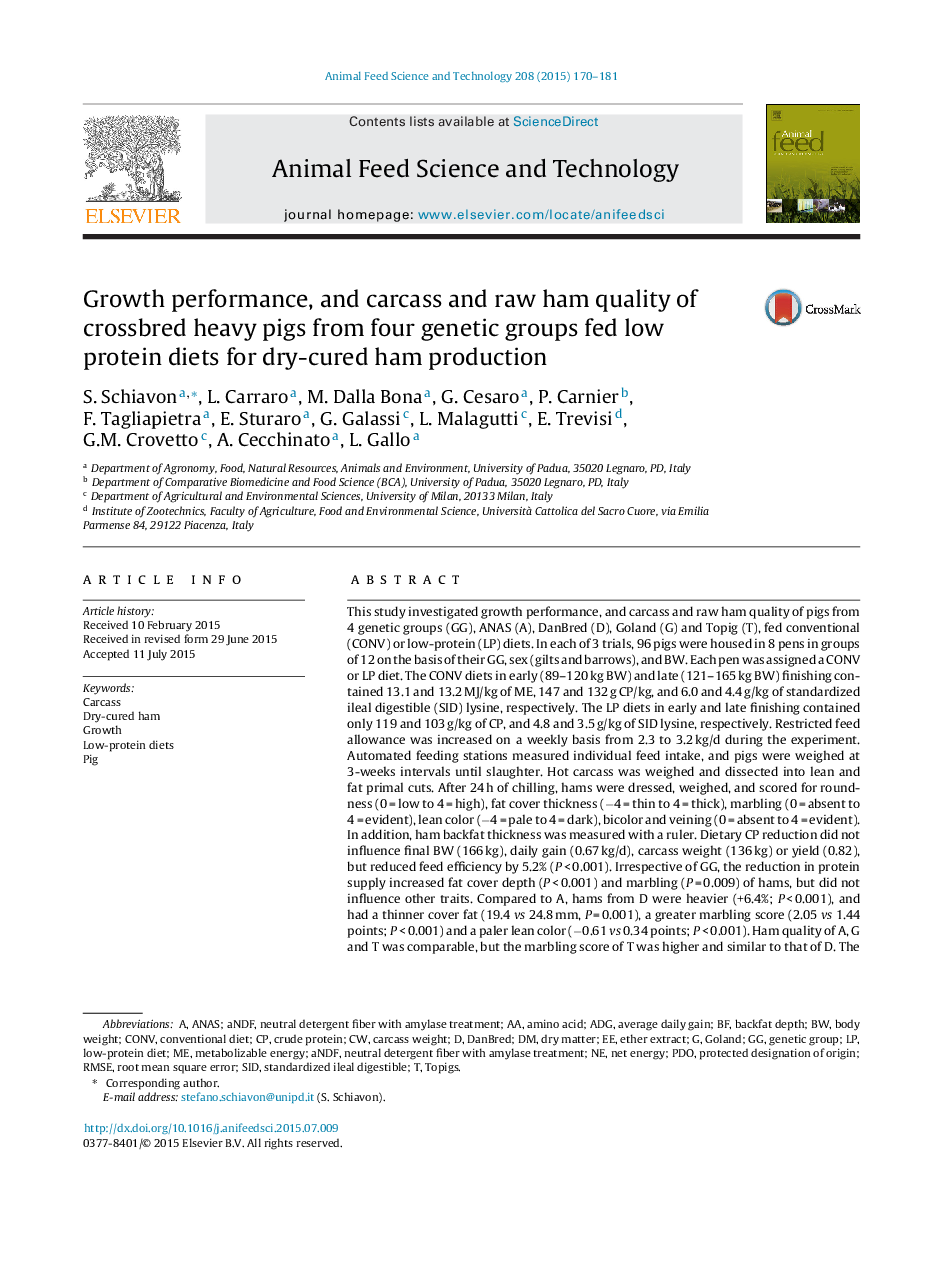| کد مقاله | کد نشریه | سال انتشار | مقاله انگلیسی | نسخه تمام متن |
|---|---|---|---|---|
| 2419496 | 1552377 | 2015 | 12 صفحه PDF | دانلود رایگان |
• Low protein diets had little influence on heavy pig carcass quality.
• A reduction in dietary protein increased fat cover and marbling of dry cured hams.
• Large influence on carcass and ham quality was mainly due to pig genetic group.
This study investigated growth performance, and carcass and raw ham quality of pigs from 4 genetic groups (GG), ANAS (A), DanBred (D), Goland (G) and Topig (T), fed conventional (CONV) or low-protein (LP) diets. In each of 3 trials, 96 pigs were housed in 8 pens in groups of 12 on the basis of their GG, sex (gilts and barrows), and BW. Each pen was assigned a CONV or LP diet. The CONV diets in early (89–120 kg BW) and late (121–165 kg BW) finishing contained 13.1 and 13.2 MJ/kg of ME, 147 and 132 g CP/kg, and 6.0 and 4.4 g/kg of standardized ileal digestible (SID) lysine, respectively. The LP diets in early and late finishing contained only 119 and 103 g/kg of CP, and 4.8 and 3.5 g/kg of SID lysine, respectively. Restricted feed allowance was increased on a weekly basis from 2.3 to 3.2 kg/d during the experiment. Automated feeding stations measured individual feed intake, and pigs were weighed at 3-weeks intervals until slaughter. Hot carcass was weighed and dissected into lean and fat primal cuts. After 24 h of chilling, hams were dressed, weighed, and scored for roundness (0 = low to 4 = high), fat cover thickness (−4 = thin to 4 = thick), marbling (0 = absent to 4 = evident), lean color (−4 = pale to 4 = dark), bicolor and veining (0 = absent to 4 = evident). In addition, ham backfat thickness was measured with a ruler. Dietary CP reduction did not influence final BW (166 kg), daily gain (0.67 kg/d), carcass weight (136 kg) or yield (0.82), but reduced feed efficiency by 5.2% (P < 0.001). Irrespective of GG, the reduction in protein supply increased fat cover depth (P < 0.001) and marbling (P = 0.009) of hams, but did not influence other traits. Compared to A, hams from D were heavier (+6.4%; P < 0.001), and had a thinner cover fat (19.4 vs 24.8 mm, P = 0.001), a greater marbling score (2.05 vs 1.44 points; P < 0.001) and a paler lean color (−0.61 vs 0.34 points; P < 0.001). Ham quality of A, G and T was comparable, but the marbling score of T was higher and similar to that of D. The use of low-protein diets would reduce the environmental impact of heavy pig production with some improvement in ham quality (> subcutaneous fat depth), although increased marbling is expected. They should preferably be used with GGs that have low marbling scores under conventional conditions.
Journal: Animal Feed Science and Technology - Volume 208, October 2015, Pages 170–181
